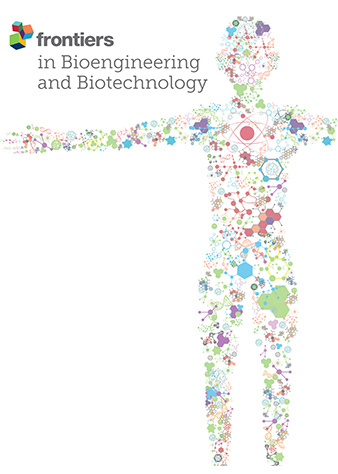确定近节指骨骨折固定装置在康复训练中承受的内部载荷
IF 4.3
3区 工程技术
Q1 BIOTECHNOLOGY & APPLIED MICROBIOLOGY
引用次数: 0
摘要
趾骨骨折很常见,尤其是在年轻患者中,由于工作年龄段的患者发病率较高,因此造成了巨大的经济负担。在骨折不稳定的创伤性病例中,钢板固定因其更高的结构刚度而越来越受欢迎。然而,由于周围软组织的炎症,这些金属板的再手术率增加了。为了克服这些挑战,我们开发了一种新型骨合成平台 AdhFix。这种方法使用一种光固化聚合物,可在传统金属螺钉周围就地塑形,形成一种类似于钢板的结构,经证实不会诱发软组织粘连。然而,要有效评估任何新型骨合成装置,首先必须了解其生物力学环境。在这项研究中,我们在模拟康复练习的情况下测量了指骨骨板骨合成的内部负荷。在一项人体手部尸体研究中,使用具有已知生物力学特性的塑料板来固定 3 毫米的截骨,并将每个手指完全屈曲以模拟传统的康复训练。利用立体摄像系统跟踪骨碎片的位移,并结合具体标本的有限元(FE)模型计算骨合成中的内部载荷。随后,制作了 AdhFix 补丁,并在类似条件下进行单调测试,以确定新技术的存活率。骨合成物的内部弯曲力矩为 6.78 ± 1.62 Nmm,在单调康复练习中,没有一个 AdhFix 补丁失效。这项研究展示了一种计算非承重运动中骨合成装置内部载荷的方法,而且在这种受控环境下,新型 AdhFix 解决方案在传统康复方案下没有失效。在临床应用之前还需要进一步的研究。本文章由计算机程序翻译,如有差异,请以英文原文为准。
Determination of the internal loads experienced by proximal phalanx fracture fixations during rehabilitation exercises
Phalangeal fractures are common, particularly in younger patients, leading to a large economic burden due to higher incident rates among patients of working age. In traumatic cases where the fracture may be unstable, plate fixation has grown in popularity due to its greater construct rigidity. However, these metal plates have increased reoperation rates due to inflammation of the surrounding soft tissue. To overcome these challenges, a novel osteosynthesis platform, AdhFix, has been developed. This method uses a light-curable polymer that can be shaped in situ around traditional metal screws to create a plate-like structure that has been shown to not induce soft tissue adhesions. However, to effectively evaluate any novel osteosynthesis device, the biomechanical environment must first be understood. In this study, the internal loads in a phalangeal plate osteosynthesis were measured under simulated rehabilitation exercises. In a human hand cadaver study, a plastic plate with known biomechanical properties was used to fix a 3 mm osteotomy and each finger was fully flexed to mimic traditional rehabilitation exercises. The displacements of the bone fragments were tracked with a stereographic camera system and coupled with specimen specific finite element (FE) models to calculate the internal loads in the osteosynthesis. Following this, AdhFix patches were created and monotonically tested under similar conditions to determine survival of the novel technique. The internal bending moment in the osteosynthesis was 6.78 ± 1.62 Nmm and none of the AdhFix patches failed under the monotonic rehabilitation exercises. This study demonstrates a method to calculate the internal loads on an osteosynthesis device during non-load bearing exercises and that the novel AdhFix solution did not fail under traditional rehabilitation protocols in this controlled setting. Further studies are required prior to clinical application.
求助全文
通过发布文献求助,成功后即可免费获取论文全文。
去求助
来源期刊

Frontiers in Bioengineering and Biotechnology
Chemical Engineering-Bioengineering
CiteScore
8.30
自引率
5.30%
发文量
2270
审稿时长
12 weeks
期刊介绍:
The translation of new discoveries in medicine to clinical routine has never been easy. During the second half of the last century, thanks to the progress in chemistry, biochemistry and pharmacology, we have seen the development and the application of a large number of drugs and devices aimed at the treatment of symptoms, blocking unwanted pathways and, in the case of infectious diseases, fighting the micro-organisms responsible. However, we are facing, today, a dramatic change in the therapeutic approach to pathologies and diseases. Indeed, the challenge of the present and the next decade is to fully restore the physiological status of the diseased organism and to completely regenerate tissue and organs when they are so seriously affected that treatments cannot be limited to the repression of symptoms or to the repair of damage. This is being made possible thanks to the major developments made in basic cell and molecular biology, including stem cell science, growth factor delivery, gene isolation and transfection, the advances in bioengineering and nanotechnology, including development of new biomaterials, biofabrication technologies and use of bioreactors, and the big improvements in diagnostic tools and imaging of cells, tissues and organs.
In today`s world, an enhancement of communication between multidisciplinary experts, together with the promotion of joint projects and close collaborations among scientists, engineers, industry people, regulatory agencies and physicians are absolute requirements for the success of any attempt to develop and clinically apply a new biological therapy or an innovative device involving the collective use of biomaterials, cells and/or bioactive molecules. “Frontiers in Bioengineering and Biotechnology” aspires to be a forum for all people involved in the process by bridging the gap too often existing between a discovery in the basic sciences and its clinical application.
 求助内容:
求助内容: 应助结果提醒方式:
应助结果提醒方式:


